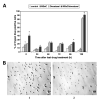The mechanism of methylselenocysteine and docetaxel synergistic activity in prostate cancer cells
- PMID: 17041098
- PMCID: PMC2826137
- DOI: 10.1158/1535-7163.MCT-05-0546
The mechanism of methylselenocysteine and docetaxel synergistic activity in prostate cancer cells
Abstract
The study was designed to evaluate the combination treatment of methylselenocysteine (MSeC) and docetaxel and to delineate the underlying mechanism associated with observed in vitro synergy between MSeC and docetaxel in prostate cancer cells. Cells were treated with different concentrations and schedules (concurrent or sequential) of MSeC and docetaxel alone or in combination. Cell growth/death was assessed with sulforhodamine B assay, trypan blue assay, and time-lapse video. Loewe synergism/antagonism model was used to determine whether the combination effect was additive, synergistic, or antagonistic. Apoptosis and caspase-3 activity were evaluated with cell death ELISA assay and caspase activity assay, respectively. Synergy between MSeC and docetaxel was further assessed in the presence and absence of z-VAD-fmk, a pan-caspase inhibitor. Effect of MSeC and docetaxel alone or in combination on the cellular expression of the antiapoptotic protein survivin was measured with Western blot analyses. Pretreatment with MSeC was crucial to enhance docetaxel antitumor activity. The enhanced antitumor activity of the sequential combination treatment of MSeC and docetaxel (MSeC/docetaxel) was highly synergistic. Apoptosis increased after MSeC/docetaxel, compared with each drug alone or concurrent treatment. Pretreatment with z-VAD-fmk converted the synergy into antagonism, suggesting that the synergy is caspase-dependent apoptosis. The survivin level was down-regulated following MSeC/docetaxel treatment when compared with each drug alone. In conclusion, pretreatment with MSeC was essential to markedly sensitize cells to docetaxel. The synergy between MSeC and docetaxel in C2G prostate cancer cells is associated with increased level of caspase-dependent apoptosis and decreased level of survivin.
Figures






References
-
- Jemal A, Siegel R, Ward E, et al. Cancer statistics, 2006. CA Cancer J Clin. 2006;56:106–30. - PubMed
-
- Landis SH, Taylor M, Bolden S, Wingo PA. Cancer statistics. CA Cancer J Clin. 1999;49:8–31. - PubMed
-
- Ringel I, Horwitz SB. Studies with RP 56976 (Taxotere): a semisynthetic analogue of Taxol. J Natl Cancer Inst. 1991;83:288–91. - PubMed
-
- Diaz JF, Andreu JM. Assembly of purified GDP-tubulin into micro-tubules induced by Taxol and Taxotere: reversibility, ligand stoichiometry, and competition. Biochemistry. 1993;32:2747–55. - PubMed
-
- Dumontet C, Sikic BI. Mechanisms of action of and resistance to antitubulin agents: microtubule dynamics, drug transport, and cell death. J Clin Oncol. 1999;17:1061–70. - PubMed
Publication types
MeSH terms
Substances
Grants and funding
LinkOut - more resources
Full Text Sources
Research Materials

